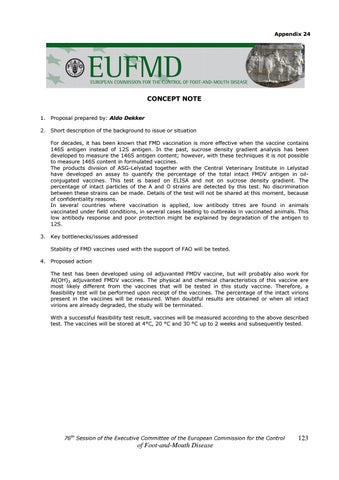Appendix 24
CONCEPT NOTE 1. Proposal prepared by: Aldo Dekker 2. Short description of the background to issue or situation For decades, it has been known that FMD vaccination is more effective when the vaccine contains 146S antigen instead of 12S antigen. In the past, sucrose density gradient analysis has been developed to measure the 146S antigen content; however, with these techniques it is not possible to measure 146S content in formulated vaccines. The products division of ASG-Lelystad together with the Central Veterinary Institute in Lelystad have developed an assay to quantify the percentage of the total intact FMDV antigen in oilconjugated vaccines. This test is based on ELISA and not on sucrose density gradient. The percentage of intact particles of the A and O strains are detected by this test. No discrimination between these strains can be made. Details of the test will not be shared at this moment, because of confidentiality reasons. In several countries where vaccination is applied, low antibody titres are found in animals vaccinated under field conditions, in several cases leading to outbreaks in vaccinated animals. This low antibody response and poor protection might be explained by degradation of the antigen to 12S. 3. Key bottlenecks/issues addressed Stability of FMD vaccines used with the support of FAO will be tested. 4. Proposed action The test has been developed using oil adjuvanted FMDV vaccine, but will probably also work for Al(OH)3 adjuvanted FMDV vaccines. The physical and chemical characteristics of this vaccine are most likely different from the vaccines that will be tested in this study vaccine. Therefore, a feasibility test will be performed upon receipt of the vaccines. The percentage of the intact virions present in the vaccines will be measured. When doubtful results are obtained or when all intact virions are already degraded, the study will be terminated. With a successful feasibility test result, vaccines will be measured according to the above described test. The vaccines will be stored at 4°C, 20 °C and 30 °C up to 2 weeks and subsequently tested.
76th Session of the Executive Committee of the European Commission for the Control
of Foot-and-Mouth Disease
123




